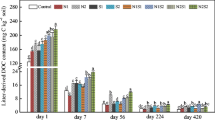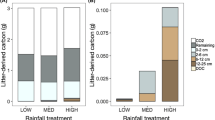Abstract
Newly shed foliar plant litter often has a decomposition rate of ca 0.1–0.2% day−1, which decreases greatly with time and may reach 0.0001 to 0.00001% day−1 or lower in litter material in the last stages of decay. The decrease in decomposability (substrate quality) varies among species and is complex, involving both direct chemical changes in the substrate itself and the succession in microorganisms able to compete for substrate with a given chemical composition. In late stages, the decomposition appears very little affected by climate, suggesting that climate change will have little effect on late-stages decomposition rates. Here, we apply a model for the late stages of litter decomposition to address the question of climate-change effects on soil-C storage. Decomposition of litter turning into soil organic matter (SOM) is determined by the degradation rate of lignin. In the last phases of decay, raised N concentrations have a rate-retarding effect on lignin degradation and thus on the decomposition of far-decomposed litter and litter in near-humus stages. The retardation of the decomposition rate in late stages may be so strong that decomposition reaches a limit value at which total mass losses virtually stop. At such a stage the remaining litter would be close to that of stabilized SOM. The estimated limit values for different species range from about 45 to 100% decomposition indicating that between 0 and 55% should either be stabilized or decompose extremely slowly. For no less than 106 long-term studies on litter decomposition, encompassing 21 litter types, limit values were significantly and negatively related to N concentration, meaning that the higher the N concentration in the newly shed litter (the lower the C/N ratio) the more litter was left when it reached its limit value. Trees growing under warmer and wetter climates (higher actual evapotranspiration, AET) tend to shed foliar litter more rich in N than those growing under colder and drier climates. A change in climate resulting in higher AET would thus mean that within species, e.g., Scots pine, a higher N level in the foliar litter may result. Further, within the boreal system deciduous species appear to have foliar litter richer in N than have conifers and within the conifers group, Norway spruce has needle litter more rich in N than, e.g., Scots pine. Thus, a change of species (e.g., by planting) from pine to spruce or from spruce to a deciduous species such as birch may result in a higher N level in the litter fall at a given site. In both cases the result would be a lower limit value for decomposition. The paper presents an hypothesis, largely based on available data that a change in climate of 4° higher annual average temperature and 40% higher precipitation in the Baltic basin would result in higher N levels in litter, lower decomposition and thus a considerable increase in humus accumulation.
Similar content being viewed by others
References
Aerts R 1997 Climate, leaf litter chemistry and leaf-litter decomposition in terrestrial ecosystems-a triangular relationship. Oikos 79, 439-449.
Axelsson G and Berg B 1988 Fixation of ammonia (15N) to Scots pine needle litter in different stages of decomposition. Scand. J. For. Res. 3, 273-280.
Berg B 1998 A maximum limit for foliar litter decomposition-a synthesis of data from forest systems. Reports from the Departments of Forest Ecology and Forest Soils, Swedish University of Agricultural Sciences. Report 77, 158 pp.
Berg B 2000 Litter decomposition and organic matter turnover in northern forest soils. Conference on 'The Ecology and management of Northern Forest Soils-An International Workshop' Prince George, BC, Canada. 13-18th June 1998. Forest Ecology and Management 133, 13-22.
Berg B and Ekbohm G 1991 Litter mass-loss rates and decomposition patterns in some needle and leaf litter types. Long-term decomposition in a Scots pine forest VII. Can. J. Bot. 69, 1449-1456.
Berg B and Matzner E 1997 Effect of N deposition on decomposition of plant litter and soil organic matter in forest systems. Environ. Rev. 5, 1-25.
Berg B and Staaf H 1980 Decomposition rate and chemical changes of Scots pine needle litter. II. Influence of chemical composition. In Structure and Function of Northern Coniferous Forests-An Ecosystem Study. (Ed.) Persson T Ecol. Bull. (Stockholm) 32, 373-390.
Berg B, Wessen B and Ekbohm G 1982 Nitrogen level and lignin decomposition in Scots pine needle litter. Oikos 38, 291-296.
Berg B, McClaugherty C, Virzo De Santo A, Johansson M-B and Ekbohm G 1995b De-composition of forest litter and soil organic matter-a mechanism for soil organic matter buildup? Scand. J. For. Res. 10, 108-119.
Berg B, Calvo de Anta R, Escudero A, Johansson M-B, Laskowski R, Madeira M, McClaugherty C, Meentemeyer V, Reurslag A and Virzo De Santo A 1995a The chemical composition of newly shed needle litter of different pine species and Scots pine in a climatic transect. Long-term decomposition in a Scots pine forest X. Can. J. Bot. 73, 1423-1435.
Berg B, McClaugherty C and Johansson M 1993 Litter mass-loss rates in late stages of decomposition at some climatically and nutritionally different pine sites. Long-term decomposition in a Scots pine forest VIII. Can. J. Bot. 71, 680-692.
Berg B, Ekbohm G, Johansson M-B, McClaugherty C, Rutigliano F and Virzo De Santo A 1996 Maximum decomposition limits of forest litter types-a synthesis. Can. J. Bot. 74, 659-672.
Berg B, Laskowski R and Virzo De Santo A 2000a Estimated N concentration in humus as based on initial N concentration in foliar litter-a synthesis. Long-term decomposition in a Scots pine forest. Can. J. Bot. 77, 1712-1722.
Berg B, Meentemeyer V and Johansson M-B 2000b Litter decomposition in a climatic transect of Norway spruce forests-climate and lignin control of mass-loss rates. Can. J. For. Res. 30, 1136-1147.
Couteaux M-M, McTiernan K, Berg B, Szuberla D and Dardennes P 1998 Chemical composition and carbon mineralisation potential of Scots pine needles at different stages of decomposition. Soil Biol. Biochem. 30, 583-595.
Eriksson K-E, Blanchette R-A and Ander P 1990 Microbial and enzymatic degradation of wood and wood components. Springer Series in Wood Science. Springer, Berlin.
Fog K 1988 The effect of added nitrogen on the rate of decomposition of organic matter. Biol. Rev. 63, 433-462.
Fogel R and Cromack K 1977 Effect of habitat and substrate quality on Douglas fir litter decomposition in western Oregon. Can. J. Bot. 55, 1632-1640.
Garten CT, Cooper LW, Post WM and Hanson PJ 2000 Climate controls on forest soil isotope ratios in the Southern Appalachian Mountains. Ecology 81, 1108-1119.
Howard PJA and Howard DM 1974 Microbial decomposition of tree and shrub leaf litter. 1. Weight loss and chemical composition of decomposing litter. Oikos 25, 311-352.
Johannesson T, Jonsson T, Källen E and Kaas E 1995 Climate change scenarios for the Nordic countries. Climate Res. 5, 181-195.
Johansson M-B 1995 The chemical composition of needle and leaf litter from Scots pine, Norway spruce and white birch in Scandinavian forests. Forestry 68, 49-62.
Johansson M-B, Berg B and Meentemeyer V 1995 Litter mass-loss rates in late stages of decomposition in a climatic transect of pine forests. Long-term decomposition in a Scots pine forest. IX. Can. J. Bot. 73, 1509-1521.
Matzner E 1988 Der Stoffumsatz zweier Waldökosysteme im Solling. Berichte des Forschungszentrums Waldökosysteme/Waldsterben, Reihe A, Bd 40 (In German).
McClaugherty C and Berg B 1987 Cellulose, lignin and nitrogen levels as rate regulating factors in late stages of forest litter decomposition. Pedobiologia 30, 101-112.
Meentemeyer V 1978 Macroclimate and lignin control of litter decomposition rates. Ecology 59, 465-472.
Nömmik H and Vahtras K 1982 Retention and fixation of ammonium and ammonia in soils. In Nitrogen in Agricultural Soils. Ed. F.J. Stevenson. pp 123-171. AgronomyMonographs, No. 22. Agronomy Society of America. Madison, WI.
Norden B and Berg B 1990 A non-destructive method (solid state 13C-NMR) determining organic-chemical components in decomposing litter. Soil Biol. Biochem. 22, 271-275.
Reurslag AM and Berg B 1993 Rapport över litteraturstudie rörande mängd ochkemisk sammansättning av fallförna samt mängd av organiskt material i skogsmark. Vattenfalls rapportserie No UB 1993/2 110 pp (In Swedish, English summary).
Staaf H and Berg B 1981 Plant litter input. In Terrestrial Nitrogen Cycles. Processes, Ecosystem Strategies and Management Impacts. Eds. FE Clark and T Rosswall. Ecol. Bull. (Stockholm) 33, 147-162.
Staaf H and Berg B 1982 Accumulation and release of plant nutrients in decomposing Scots pine needle litter. Long-term decomposition in a Scots pine forest II. Can. J. Bot. 60, 1561-1568.
Strömgren M, Linder S and Gower ST 1999 Effects of soil warming in a boreal forest. Poster, at GCTE and IGBP Conference proceedings. Abisko 15-18 June, 1999. How nutrient cycles constrain carbon balances in boreal forests and arctic tundra.
Wardle DA, Zachrisson O, Hörnberg G and Gallet C 1997 The influence of island area on ecosystem properties. Science 227, 1296-1299.
Author information
Authors and Affiliations
Rights and permissions
About this article
Cite this article
Berg, B., Meentemeyer, V. Litter quality in a north European transect versus carbon storage potential. Plant and Soil 242, 83–92 (2002). https://doi.org/10.1023/A:1019637807021
Issue Date:
DOI: https://doi.org/10.1023/A:1019637807021




